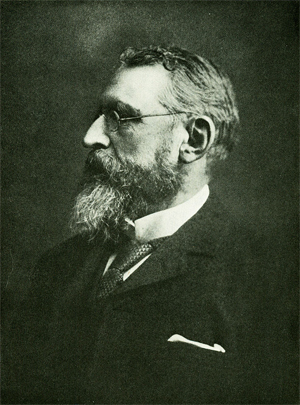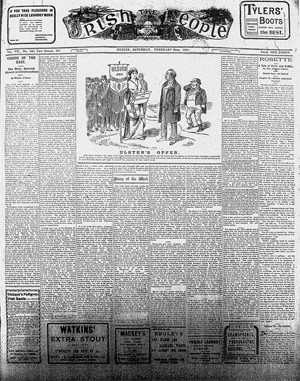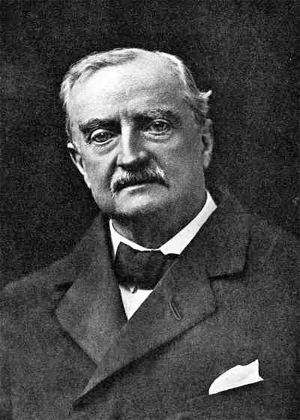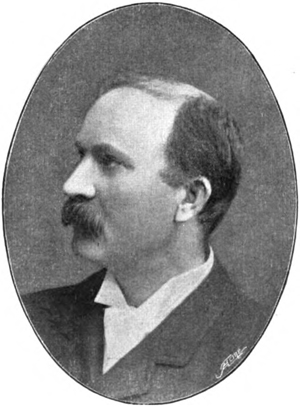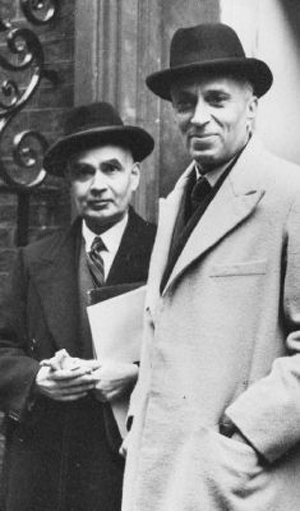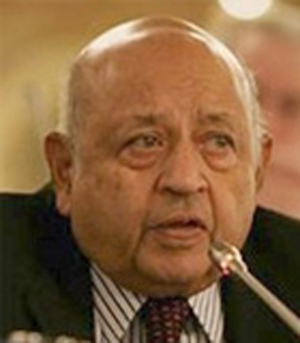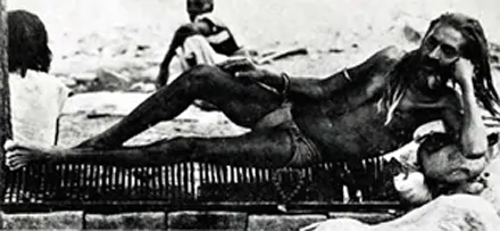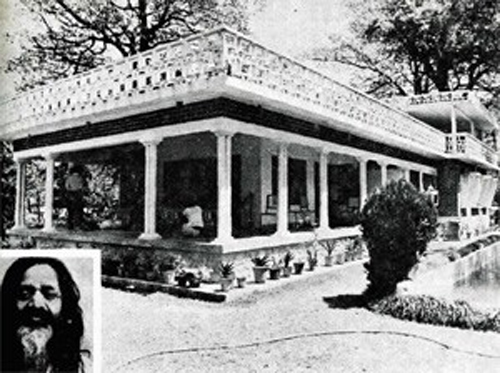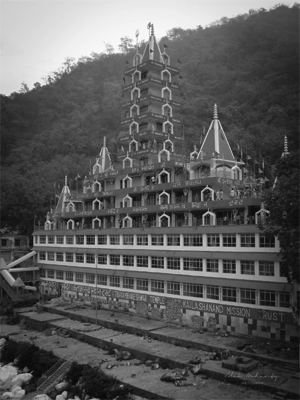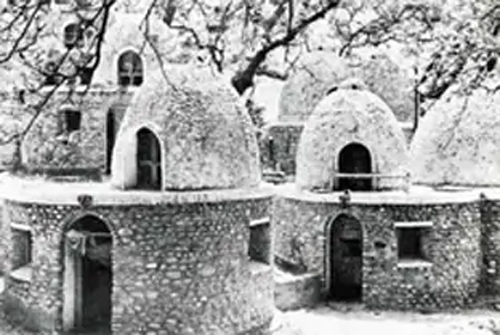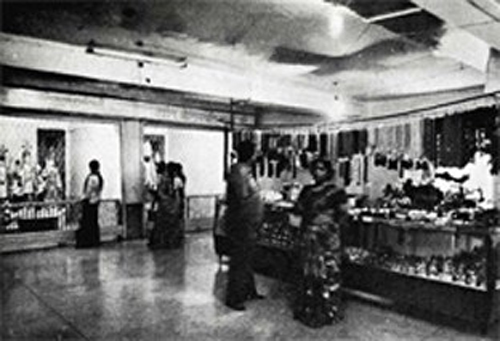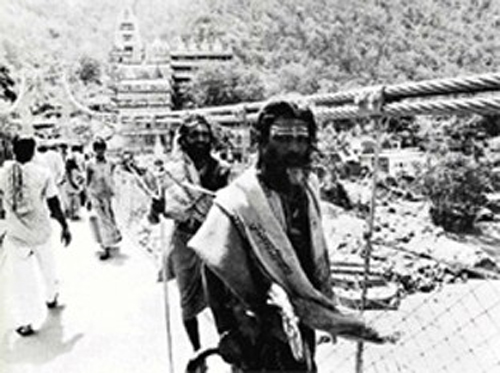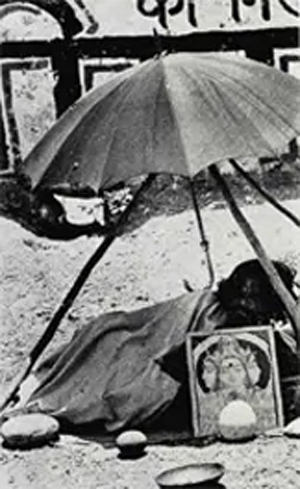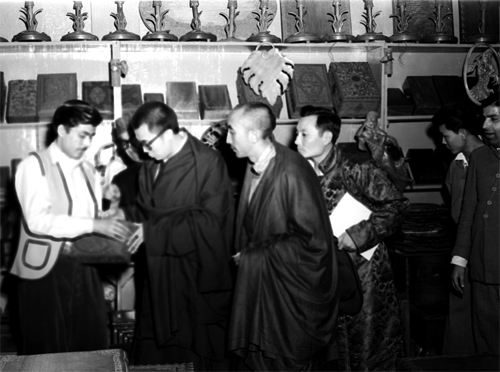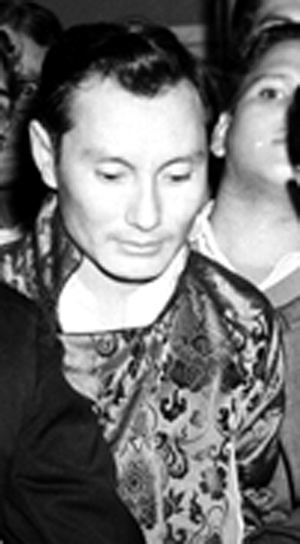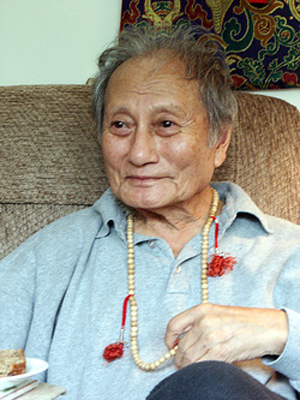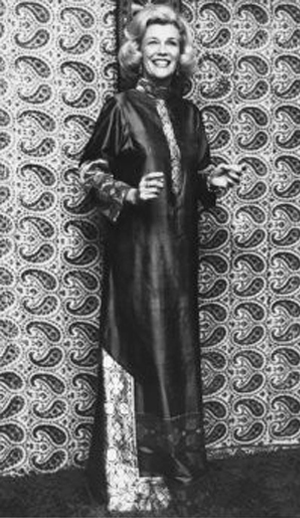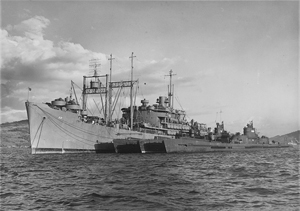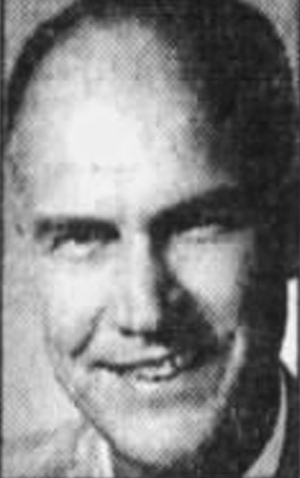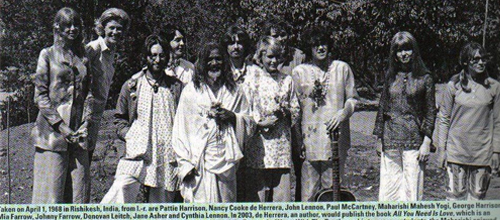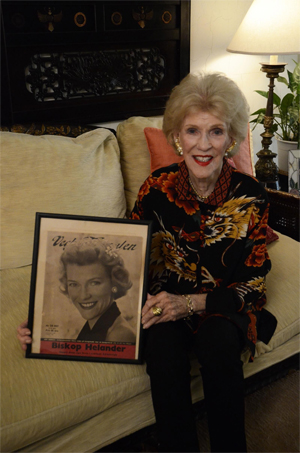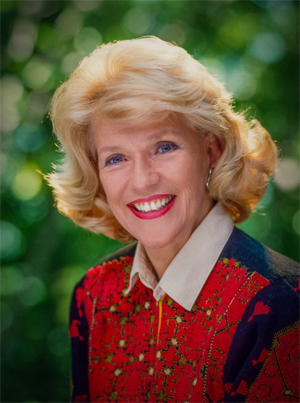Chapter 23. Politicians versus SaintsExcerpt from "All You Need is Love: An Eyewitness Account of When Spirituality Spread from the East to the West"
by Nancy Cooke de Herrera
Foreword by Deepak Chopra
Chapter 23. Politicians versus SaintsThe late '60s and early '70s were good years for me and my family, with the exception of Tony's sickness. Although he had been off cortisone since 1969, the rigidity of his frame entered his personality. I continually cautioned the children to overlook his crankiness as he became more limited with his body movements.
Even though Tony and I now lived like brother and sister, we were a good team. I threw my energies into my family, the SRM [Spiritual Regeneration Movement], traveling, and entertaining for Tony. His energy went into music and the law. I continued with my lecture series and also was a judge for the Miss California beauty contest each year.
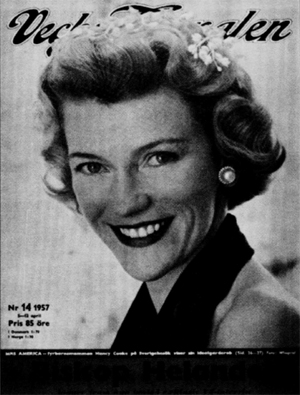 Nancy as Ambassadress of Fashion (Swedish Life Magazine, 1957)
Nancy as Ambassadress of Fashion (Swedish Life Magazine, 1957)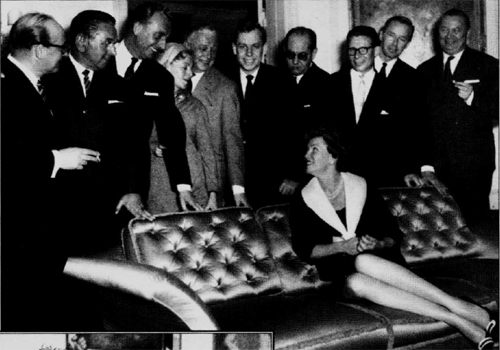 Staebe-Seger's farewell party for me, with the "West Berlin Couturiers" (Berlin, 1958).
Staebe-Seger's farewell party for me, with the "West Berlin Couturiers" (Berlin, 1958).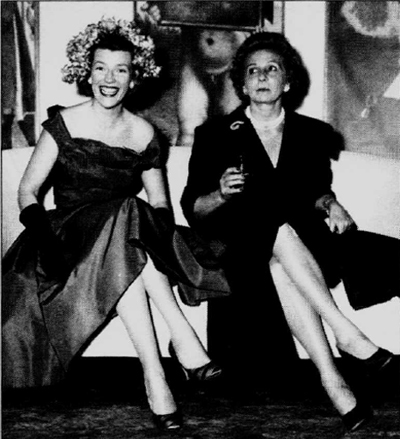 The Ambassadress of Fashion with the Princess Marcella Borghese (Rome, 1958)
The Ambassadress of Fashion with the Princess Marcella Borghese (Rome, 1958)Occasionally, we took a month's vacation to Honolulu or some place where Tony could swim. He always returned vastly improved, but then he would return to his workaholic ways. Several doctors commented that his mind was killing his body, but Tony would not listen. He took in more partners, and
the money rolled in. He didn't consider the personal cost to him and to his family life.
Maharishi taught, "You judge the effectiveness of your meditation by how your life flows." Life was flowing for us financially, if not in health. My children had come through the frantic '60s drug-free, happy, well-balanced young people with a sense of direction and joy in life. The boys missed Vietnam by flunking their health exams-two had extra vertebrae and one a heart murmur. Rik had graduated from UCLA and gone off to architecture school in Oregon; Starr was finishing Stanford; Brett still attended Yale; and Maria Luisa was happily at Westlake. I had so much to be grateful and thankful for. The only negative we had was Tony's delicate state of health.
I did a lot of traveling with the children. Brett, Maria Luisa, and I visited Spain, Italy, and Greece; Tony joined us in London. Another trip with Brett and Maria Luisa was to Berlin, where I was still working with German couture. With Brett's ability to pick up languages, he was a joy to travel with.
But no country pulled me back like India. I returned regularly to work on different secular projects -- I helped design fashions that would be attractive to Western buyers and I originated itineraries for India's Minister of Tourism. The Indian travel industry had no idea of how to present their incredible country. In 1969, under the supervision of S.K. Roy, still the Director General of Tourism, I brought 20 friends to India and gave them a 30-day "fairyland" tour. My Indian friends entertained us; we stayed in Maharajahs' palaces; we went from the untouched beaches of Trivandrum to the high peaks of Nepal. They all came back confirmed Indiaphiles.
Because of the success of my Indian trip, the airline gave me three free round-the-world passes. So, in 1970, Tony, Starr, and I went to Rishikesh together. Brett and Maria Luisa were in school, so they could not join us. The ashram had a new image. In order to accommodate the increasing numbers attending courses, the blocks had been closed in, and the porches made into rooms. Unfortunately, it was not well done.
We were given The Beatles' old block. What luxury in comparison to what I'd experienced in '68. Now there was a new ashram kitchen and dining room complex -- very nicely done, except it leaked in the rain. I was so happy to have Tony along and prayed he would enjoy the trip.
At the end of two weeks of resting and meditating, Tony looked like a different person; his aches and pains were gone. I began to hope I might get my "real husband" back, but once back in the highly competitive world of law and business, the advances soon disappeared.
It was the last time I saw Maharishi at the ashram; he was now giving most of his courses in Europe. Because of tax problems with the Indian government, he did not return to India for many years. I frequently told my Indian friends, "You have driven away your best export. You should attract Maharishi back to India. Think of the money India is losing. The thousands attending Maharishi's course would have, and should have, come here." I guess they felt TM was a flash in the pan.
Throughout this period India continued to intrigue me. No other country offers such a range of contrasts. It is a mosaic of not only people, but of traditions, climates, cultures, and scenery.
Each time I went to India I returned to the ashram to see Satyanand.
In spite of letters and phone calls advising of my arrival, the result was always the same. I would climb the hill, be greeted by peons, and nothing was ready for me. Everything was uncared for. New buildings had gone up instead of taking care of what was there. It had gone "Indian" in spite of Satyanand's supervision.
Several times returning home from India I called on Maharishi, who usually was in Italy, Spain, or Switzerland. I begged him to send a European couple to take over management of the ashram, but it fell on deaf ears. His courses grew in number and the organization became prosperous in spite of
the press, who continued to print any scandalous rumor about Maharishi that came their way -- no thought was given to authenticity.[Mia Farrow] accused Maharishi Mahesh Yogi of hitting on her when she visited the guru with The Beatles in 1968.
The Fab Four flew home from India in disgust after Mia fled the Maharishi’s cave in tears claiming the supposedly celibate swami had grabbed and groped her.
“Boys! Boys! What’s wrong? Why are you leaving?” the Maharishi shouted after them, John Lennon later recalled.
“If you’re so f - - king cosmic, you’ll know,” came Lennon’s scathing reply.
Lennon expressed his disillusionment in “Sexy Sadie” — originally titled “Maharishi” but changed to avoid legal problems — singing, “Sexy Sadie, what have you done? You made a fool of everyone.”
-- Mia Farrow claimed Beatles pal groped her, by Richard Johnson
One who did come to Maharishi's defense often was the world famous nutritionist, Dr. Gayelord Hauser. This vigorous, young 70-yearold had sold over 70 million books and was responsible for bringing yogurt to the Western world. During the fifties when I first met him in Paris, he had his followers on the blackstrap molasses, wheat germ, and yogurt kick. He had a huge following around the globe, but lived most of the year in Beverly Hills; we had become intimate friends.
He once said to me regarding lecturing, "Honey, just remember five little words, 'What's in it for me' -- that's what an audience wants to hear." His 6'3" physique was trim and tan, no fat on him. His thick, gray hair crowned a large head that was always held erect. His blue eyes were surrounded with laugh lines.
"That little guy," he said, referring to Maharishi, "really has something. People in Germany (Gayelord's place of birth) were prepared to laugh at him, instead they started to follow him."
He paused and said in a soothing voice, "Girls and boys," as he loved to address his audience, "he knows that tension is one of the worst sicknesses of America. If you meditate, tension leaves you."Side Effects of Meditation With Possible Adverse ReactionsDepersonalization, Derealization...Hallucinations, Fear of persecution, Disorientation, Poor insight and judgment, Reduced food intake...Insomnia reported as complete sleep loss...Delusions of grandeur, Thought disorder...Feelings of anxiety, Feelings of intense dysphoria, Feelings of mania...Increased epileptogenisis susceptibility...Double vision, Grandiosity/elation...Feelings of depression, including Attempted suicide...Restlessness/extreme agitation...Reports of psychosis...Decreased life motivation/boredom, Increased negativity/self-judgment...Panic and/or tension...Disorientation/confusion, Feelings of meditation “addiction”, Reports of pain ...Religious delusions...Intense fear and loneliness...Feelings of mania, including Increased talkativeness, Overactivity/restlessness, Distractible, Sexual disinhibition, Reports of psychotic symptoms, including Thought disorder with flight of ideas.
-- Mindfulness Meditation Research: Issues of Participant Screening, Safety Procedures, and Researcher Training, by M. Kathleen B. Lustyk, PhD; Neharika Chawla, MS; Roger S. Nolan, MA; G. Alan Marlatt, PhD
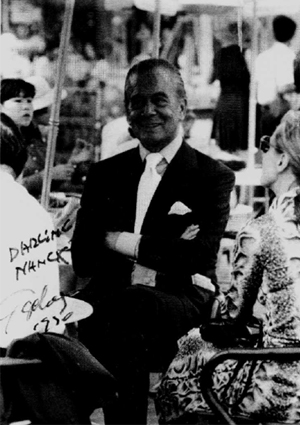
At seventy-five, a young Dr. Gayelord Hauser. He died in 1985 at age ninety.
Once, during one of his lectures, he introduced me to the 3,000 staring faces, "This is my friend Nancy. She introduced me to Maharishi and then taught me meditation, one of the great gifts in my life." A nice plug from a world figure.
Slowly I reconciled myself to the fact that my marriage situation was not going to change or get much better. I rationalized,
"I have a happy secure base for myself and the children; I've already had more romance in my life than most people; socially I belong to the best organizations and groups in the Beverly Hills/Los Angeles area-any outsider would think I lead a very glamorous life. I think so too, so what do I have to complain about?" If I were going to have a love affair, it would be with travel.
My friend Carroll Righter, the astrologer, had advised me when I'd told him of my plans to marry Tony, "Well, take lots of trips. Cancer and Aries are not a good combination -- water and fire getting together produce steam -- you'll need an escape valve for sure."
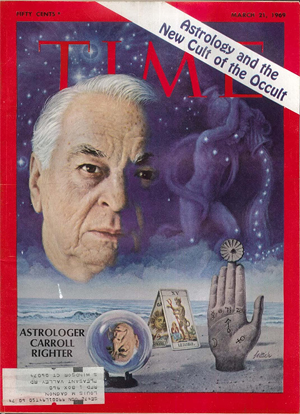 Carroll Righter (February 2, 1900 – April 30, 1988) was known as the "astrologer to the stars." He wrote a syndicated daily advice column for 166 newspapers around the world and was reputed to be an advisor to Ronald and Nancy Reagan.
Carroll Righter (February 2, 1900 – April 30, 1988) was known as the "astrologer to the stars." He wrote a syndicated daily advice column for 166 newspapers around the world and was reputed to be an advisor to Ronald and Nancy Reagan. Righter, who liked to be called the "gregarious Aquarius,' began doing charts for Hollywood notables in 1938 and became a columnist in 1950. Prior to that, he was a lawyer in Philadelphia.
Righter was mentioned in President Reagan's 1965 autobiography Where's The Rest of Me? and, according to former White House Chief of Staff Donald T. Regan, Mrs. Reagan turned to astrologers to help determine the president's schedule. Asked specifically whether he believed in astrology, President Reagan said, "I don't guide my life by it" but he added, "I don't know enough about it to say, is there something to it or not...and I don't mean to offend anyone who does believe in it, or engages in it." When Righter was asked in 1985 if he consulted with Ronald Reagan on astrology, he replied, "No comment."
Righter claimed he warned Marlene Dietrich to avoid working on a studio set one day because she might get hurt. His advice was not heeded, and Dietrich broke an ankle while reaching out to save a falling child. Word of the accident and Righter's advice led other celebrities to the astrologer, ensuring his fame. Among those who sought his advice were Arlene Dahl, Rhonda Fleming, Jane Withers, Hildegard Knef, Joan Fontaine and Grace Kelly. At one point in the late 1930s, the then-young Robert Mitchum worked as a ghost writer for Righter.
Righter wrote several books, including Astrology and You, the Astrological Guide to Health and Diet, and the Astrological Guide to Marriage and Family Relations.
-- Carroll Righter, by Wikipedia
He was right; my trips were this valve. Tony encouraged our trips; he liked the quiet times when we were away. The house was well run, and he could have his beloved Bach blaring at ear-bursting levels.
My mother once asked, "How can you stand that continual loud sound all the time when Tony is home? It would drive me mad." Houseguests often complained and asked that the music be turned down. Sir John BarbiroIIi, the well-known conductor, once provided ammunition when he said, "Tony, turn that music down! Music is to be listened to, not shouted over." Tony was Sir John's lawyer so he had to respond.
My solution was to wear earplugs, or I'd go into my bedroom and shut the door in order to concentrate on whatever I was doing. It seemed a sensible solution, now that our marriage had assumed the platonic level Dr. Bieler had predicted.
That Tony enjoyed having the house to himself was confirmed, when, against everyone else's advice, he encouraged me to go to India, just weeks after the Pak-Indian war came to an end in 1972.
"Go and present the U.S. side to our Indian friends." He loaded me down with all sorts of information and data and practically pushed me out the door.It wasn't a happy trip. None of the children could go with me, so this time I went alone.
Once back in India, I did nothing for six weeks but argue that President Nixon had tried not to take sides in the war. Originally, Pakistan and India had been offered the same armaments deal. The former accepted, while the latter haughtily turned it down. U.S. columnists Leon Frankel and Jack Anderson, with their violently anti-Nixon views, had done much to erode friendship between India and the U.S. As the only U.S. journalists heard from in Indian newspapers, India judged the U.S. attitude by their writings.
My friend Piloo Mody tried to explain these attacks. "The Indians, having won what on a world scale was a small military battle, are now plumped up like proud pigeons. Don't let them get to you, Nancy."
Then my Parsee friend added, "And don't forget, Nancy, arrogance comes easily to an Indian."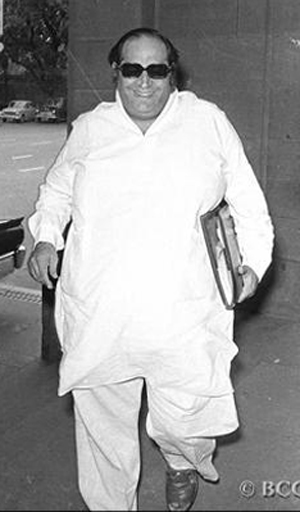
Piloo Mody (14 November 1926 – 29 January 1983) was an Indian architect and politician and
one of the founding members of the Swatantra Party....The Swatantra Party was an
Indian classical liberal political party, that existed from 1959 to 1974.
It was founded by C. Rajagopalachari in reaction to what he felt was the Jawaharlal Nehru-dominated Indian National Congress's increasingly socialist and statist outlook.It had a number of distinguished leaders, most of them old Congressmen, for example, C. Rajagopalachari, Tanguturi Prakasam Pantulu, Minoo Masani, N.G. Ranga, Darshan Singh Pheruman, Udham Singh Nagoke and K.M. Munshi.
Right-wing groups and parties had existed earlier at the local and regional levels, but Swatantra’s formation was the first attempt to bring these highly fragmented right-wing forces together under the umbrella of a single party. The provocation was the left turn which the Congress took at Avadi[11] and the Nagpur Resolutions.
Swatantra stood for a market-based economy with the "Licence Raj" dismantled, although it opposed laissez faire policies. The party was thus favoured by some traders and industrialists, but at the state-level, its leadership was dominated by the traditional privileged classes such as zamindars (feudal landlords) and erstwhile princes. Located on the right of the Indian political spectrum Swatantra was not a communal party; its membership was not restricted on the basis of religion, unlike the Hindu-nationalist Bharatiya Jana Sangh. In 1960, Rajagopalachari and his colleagues drafted a 21-point manifesto detailing why Swatantra had to be formed, even though they were hitherto Congressmen and associates of Nehru during the struggle for independence.
The Prime Minister Jawaharlal Nehru was highly critical of Swatantra, dubbing the party as belonging to "the middle ages of lords, castles and zamindars".-- Swatantra Party, by Wikipedia
In 1975, at the time of the Emergency in India, Mody was arrested on the orders of the Indira Gandhi government, using the controversial powers granted by the Maintenance of Internal Security Act.
After an absence of a year from parliament, on 10 April 1978 Mody joined the Rajya Sabha and served there until his death in 1983.
-- Piloo Mody, by Wikipedia
But, eventually,
it did get to me. I couldn't understand why all of India seemed so anti-U.S. We did have a record of trying to help them over the years with a massive educational and agricultural aid program. Was this all forgotten, or was it just an illustration of this story:
"One day, Confucius, walking with a friend, nodded in recognition to a man coming toward him. The other man defiantly ignored his acknowledgment. Confucius turned to his companion, 'What strange behavior; I don't remember having ever helped him.'''
However, one evening,
while dining with Goodie and Bikki Oberoi in their penthouse suite at the Oberoi Intercontinental,...
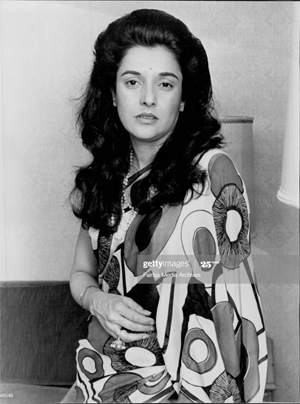 Goodie Oberoi
Goodie Oberoi
an energetic, hawk-nosed, mustachioed man strode into the room, carrying a plastic bag full of greens.
"Here, enjoy this lettuce. It was raised in my garden, and I can guarantee no bloke has ever peed on it." He was introduced to me as Uncle Sam, my escort for the evening. He had a forceful, outgoing personality. When he heard I was on my way to Israel, he asked me to get some information on solar heating and water collection methods. I agreed and asked his full name and address.
Goodie laughed, "Ail you have to put on the envelope is Field Marshal Sam Manekshaw, India. He's the general who won our war."
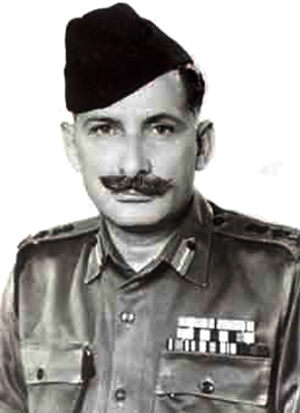 Field Marshal Sam Hormusji Framji Jamshedji Manekshaw, MC (3 April 1914 – 27 June 2008), widely known as Sam Manekshaw and Sam Bahadur ("Sam the Brave"), was the Chief of the Army Staff of the Indian Army during the Indo-Pakistani War of 1971, and the first Indian Army officer to be promoted to the rank of field marshal. His military career spanned four decades and five wars, beginning with service in the British Indian Army in World War II....
Field Marshal Sam Hormusji Framji Jamshedji Manekshaw, MC (3 April 1914 – 27 June 2008), widely known as Sam Manekshaw and Sam Bahadur ("Sam the Brave"), was the Chief of the Army Staff of the Indian Army during the Indo-Pakistani War of 1971, and the first Indian Army officer to be promoted to the rank of field marshal. His military career spanned four decades and five wars, beginning with service in the British Indian Army in World War II....Having already commanded troops at division, corps and regional levels, Manekshaw became the seventh chief of the army staff in 1969. Under his command, Indian forces conducted victorious campaigns against Pakistan in the Indo-Pakistani War of 1971, which led to the creation of Bangladesh in December 1971. He was awarded the Padma Vibhushan and the Padma Bhushan, the second and third highest civilian awards of India. In January 1973, Manekshaw was conferred with the rank of Field Marshal, the first army officer of independent India to be so honoured.
-- Sam Manekshaw, by Wikipedia
He had attended Sandhurst with the Pakistani President, General Yaya Khan and had psyched him out on every tactic, knowing exactly how the general's mind worked. At one moment, when Sam had Delhi practically surrounded by tanks, an anti-Gandhi sympathizer reportedly asked him, "Why don't you just take India." Sam replied, "Who wants it?"
He was presently the only Indian Field Marshall. How different his attitude was. He spoke with warmth and admiration for the U.S. and excused the Indians' excessive pride over their "little skirmish." He even spoke well of Ali Bhutto who, becoming Prime Minister of Pakistan, had the job of soothing the wounded national pride of his countrymen over the loss of Bangladesh -- a loss that Bhutto later confessed to me had probably been a blessing. This was during a trip I made to Pakistan in '74.
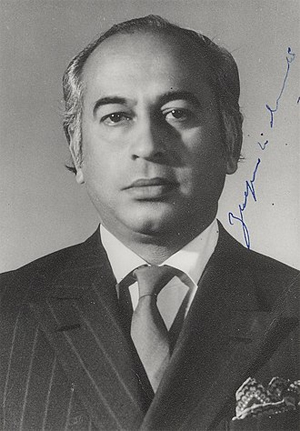
Zulfikar Ali Bhutto (Sindhi: ذوالفقار علي ڀٽو; Urdu: ذوالفقار علی بھٹو; 5 January 1928 – 4 April 1979) was a Pakistani barrister and politician who served as the 9th Prime Minister of Pakistan from 1973 to 1977, and prior to that as the fourth President of Pakistan from 1971 to 1973. He was also the founder of the Pakistan People's Party (PPP) and served as its chairman until his execution in 1979.
Born in modern-day Sindh and educated at the University of California, Berkeley and the University of Oxford, Bhutto trained as a barrister at Lincoln's Inn, before entering politics as one of President Iskander Mirza's cabinet members, and was assigned several ministries during President Ayub Khan's military rule from 1958. Appointed Foreign Minister in 1963, Bhutto was a proponent of Operation Gibraltar in Kashmir, leading to war with India in 1965. After the Tashkent Agreement ended hostilities, Bhutto fell out with Ayub Khan and was sacked from government.
Bhutto founded the PPP in 1967 on a socialist platform, and contested general elections held by President Yahya Khan in 1970. While the Awami League won a majority of seats overall, the PPP won a majority of seats in West Pakistan; the two parties were unable to agree on a new constitution in particular on the issue of Six Point Movement which many in West Pakistan saw as a way to break up the country. Subsequent uprisings led to the secession of Bangladesh, and Pakistan losing the war against Bangladesh-allied India in 1971. Bhutto was handed over the presidency in December 1971 and emergency rule was imposed. When Bhutto set about rebuilding Pakistan, he stated his intention was to "rebuild confidence and rebuild hope for the future".
By July 1972, Bhutto recovered 43,600 prisoners of war and 5,000 sq mi of Indian-held territory after signing the Simla Agreement. He strengthened ties with China and Saudi Arabia, recognised Bangladesh, and hosted the second Organisation of the Islamic Conference in Lahore in 1974. Domestically, Bhutto's reign saw parliament unanimously approve a new constitution in 1973, upon which he appointed Fazal Ilahi Chaudhry President and switched to the newly empowered office of Prime Minister. He also played an integral role in initiating the country's nuclear programme. However, Bhutto's nationalisation of much of Pakistan's fledgling industries, healthcare, and educational institutions led to economic stagnation. After dissolving provincial feudal governments in Balochistan was met with unrest, Bhutto also ordered an army operation in the province in 1973, causing thousands of civilian casualties.
Despite civil disorder, the PPP won parliamentary elections in 1977 by a wide margin. However, the opposition alleged widespread vote rigging, and violence escalated across the country. On 5 July that same year, Bhutto was deposed in a military coup by his appointed army chief Zia-ul-Haq, before being controversially tried and executed by the Supreme Court of Pakistan in 1979 for authorising the murder of a political opponent.
-- Zulfikar Ali Bhutto, by Wikipedia
Finally, getting fed up with politics in the capital city of India, I decided to travel south to check out some new potential tourist attractions and several holy men I'd been hearing about. In Madras, I had a delightful spiritual encounter. I sought out the Shankaracharya of that area. It reminded me of the quests Tom and I had made together.
Though advised that I'd never find him, and even if I did, he wouldn't see me, I took a young Indian guide, Vigi, and we set out in an Indian-made Ambassador. Having no air conditioner, we had to leave the windows open, so we arrived at the marketplace of ancient Kanchipuram hot and covered with dust.
Crumbling sandstone temples surrounded a square filled with exotic colors, pungent smells and people hawking their wares. Southern Indians seem smaller and darker than Northern Indians, and in Madras they speak Tamil, not Hindi. Most of the young women had woven fragrant flowers in their hair. We bought bright orange flower garlands mixed with sweet narcissus, and asked for news of the aged sage whose only mode of travel was walking. If he were nearby, the people would know it, as he was one of the most revered saints in India.
"Yes, he is here. He arrived yesterday." So the tip we'd been given was correct. A skinny arm pointed the direction.
The Swami's place of refuge was a small building with a thatched roof. In front was a water well. A group of people stood waiting. A white-robed Indian explained to Vigi in Tamil, "Tell Memsahib Swami does not see Europeans."
I persisted, "Please explain to the Shankaracharya that I am a follower of Maharishi's and the wisdom of Shankara. I do my puja every day and I have come to receive his darshan."
He disappeared, then came back to say, "It is all right, Memsahib, please stand behind these people."
I felt so happy as we waited for the Swami to appear. I studied the group in front. All were men, and by the sacred threads around their shoulders, they were of the Brahmin caste. Many times I had seen Maharishi give deference to a Brahmin over another of a lesser caste.
A hush fell over the group as a white-haired old man slowly emerged and stood at the other side of the well. His skin was dry and parched from years of walking in the relentless sun of Southern India. His hand grasped a staff. He looked at us with pale eyes and said nothing. His aide motioned to the first Brahmin. He prostrated himself on the ground and, rolling back and forth, wailed out his story.
"He has a very sick wife," Vigi explained.
Each came forward and repeated a similar tale. He hardly acknowledged them.
Then my turn came. Vigi told me it was not expected for me to roll on the ground. I went toward the well and gave my flowers to the aide. Vigi explained who I was and what was in my heart as I spoke my words in English. The old Swami beckoned me closer to the well. He peered at me closely with seemingly blind eyes. Then his parched face cracked with a slight smile, which revealed toothless gums. He moved forward and put the Brahmin's garlands around our necks. Then he turned and slowly left us. A tremendous surge of love filled my being.
Vigi and I wordlessly got back into our taxi. Months later, he wrote, "I had not been to the temple for a long time, and my family was upset with me. Now I go regularly and am studying our scriptures. My family is happy and joyous over the change that has taken place in me since I had the good karma to go with you to Kanchipuram."
Before leaving Kanchipuram, I bought an exquisite sari -- one typical of that place, so I would always have a material reminder of that experience with the old Shankaracharya. Experiences such as these were the jewels I gathered in India.
My love affair with India continued. Friends, who consider me an expert on the "subcontinent," frequently ask to "tag along" on my next trip. So, several times I took a group of friends to India; Rik went as my assistant. With one year of architectural school behind him, Rik became convinced that photography would be his profession, and architecture his hobby. These trips provided a good opportunity for selling photos to magazines.
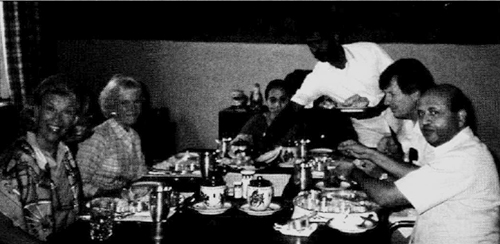
Ambassador and Mrs. Shankar Bajpai (Beijing, China, 1980)
In 1970, Shankar Bajpai wrote, suggesting we visit him in Gangtok, Sikkim. He had been the Indian Consul General in San Francisco in the '60s, and we'd met through B.K. Nehru. Now he was the Political Officer of Sikkim, which meant he ran the place, as India provided the small mountain country with its foreign policy, currency, and military presence. (Later, India swallowed it up as it did Goa, all the time criticizing the U.S. for expansionist policies in Vietnam.) His letter was provocative, "Two hours from Gangtok there is an exotic monastery in Rumtek. The top boy is a very important Tibetan Lama. Rik will get dramatic pictures and you can have the thrill of knowing another saint."He loved to kid me about my holy friends.
We decided to do it and put a group of friends together. Taking people to India was turning out to be a new hobby for me. Shankar and his wife, Meera, were delighted. He wrote again, "Before you leave Darjeeling, call me. It's always a frightful bore at the border. Just to be on the safe side, I'll have my men waiting for you. And by the way, do you suppose you could bring me about 12 pounds of fresh pork? If so, we'll have an authentic Tibetan dinner for you."
He went on to name a few other items impossible to get in the tiny kingdom.
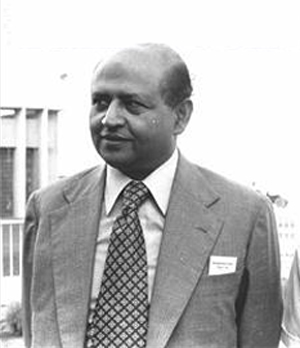
K Shankar Bajpai (l), Indian ambassador to Pakistan in New Delhi on July 20, 1976.
Librarian of Congress James H. Billington has named K. Shankar Bajpai—who served as India’s ambassador to Pakistan, China and the United States—as Distinguished Visiting Scholar at the Library’s John W. Kluge Center.
At the Library, Bajpai hopes to explore the roots and history of Indo-American relations, and to examine more closely the question of post-colonial attitudes towards the colonial experience. Bajpai’s appointment started in mid-June and will run approximately three months, until September 22.
Bajpai also served as India’s Secretary of the Ministry of External Affairs, the country’s top diplomat, from 1982 to 1983. The son of India’s Agent-General to the United States during World War II, Bajpai spent many of his formative years in Washington, D.C. An expert in security issues, he joined the Indian Foreign Service in 1952. Bajpai served in Germany, Turkey and Pakistan. He was named ambassador to Pakistan from 1976 to 1980, to China from 1980 to 1982 and to the United States from 1984 to 1986.
On retirement from government service in 1986, he entered academic life, working as a professor at the University of California, Berkeley, and as the first professor of non-Western studies at Brandeis University. He has been a visiting fellow at Stanford University’s Center for International Security and Cooperation, and the co-founder and chairman of the Delhi Policy Group, an independent policy analysis center in India. The author of numerous articles on diplomacy, foreign affairs and national security, Bajpai was editor of “Democracy and Diversity: Comparing India and the United States” (2007)...-- K. Shankar Bajpai Named Distinguished Visiting Scholar at Library of Congress' John W. Kluge Center, by Library of Congress, July 21, 2009
Months later, through the Tenduf-las, the owners of the old-fashioned, cozy Windemere [Windamere] Hotel in Darjeeling where we stayed, it was possible to find everything.
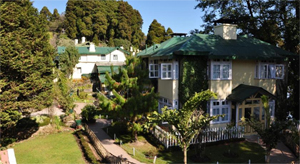
The hotel started out as boarding house for bachelor British tea planters in Darjeeling, in what was then British India, were built in 1841 and opened up as a boarding house in the late 1880s.
The property named Adda Villa is owned by the family of Robin Mookerjee. It was leased to Tenduf La, a Sikkimese of Tibetan descent, who turned it into a hotel with the name Windamere. The hotel became more widely known as Darjeeling became the Bengal Presidency's summer capital. It expanded and took over a new wing, formerly the Loreto Convent, where the actress Vivien Leigh had spent some years in childhood.
In 1959, Palden Thondup Namgyal, Crown Prince of Sikkim, met his future wife Hope Cooke for the first time in the Windamere Hotel.The hotel is also known for its views of the tea plantations below and of Mount Kangchenjunga, the third highest peak in the world.
-- Windamere Hotel, by Wikipedia
From our hotel on the highest part of Darjeeling, our group caravan dropped over the backside of the mountain on a winding road down to a turbulent river. Crossing the gorge, we started the climb up the next mountain to enter the Kingdom of Sikkim-about a four-hour scenic drive. Bajpai's men were there, and we passed through the official gate with no problems.
As we approached the official residence, we saw the Bajpais sitting in lawn furniture in front of the government house, having tea. Shankar's round face broke into a wide smile as he welcomed us to Gangtok in his flawless English. Light reflected off his baldpate; he looked like a Buddha in his warm, monk-like robe. Meera had a woolen shawl around her sari. The mountain air was cool.
"Come join us. I'm sure you're all ready for a good hot cup of tea." We blessed the British. And what an enchanted tea it was. Good conversation was as available as good food when around the Bajpais. Oxford-educated Shankar was a popular diplomat for India. His next ambassadorial posts were to China, Pakistan, and the United States.
The next morning, the sun backlighted Kachenjunga, the huge mountain worshipped by the Sikkimese. Through the leaded windows of my room in Raj Bavan, another colonial gingerbread house, I watched the spectacular sunrise. Often the magnificent mountain was hidden by cloud cover, but not this morning. There it was, soaring 29,000 feet into the air, dwarfing the rest of the Himalayan chain. It was so cold as I stood there that I had my electric heater in my hand. Luckily it had a long cord and went everywhere in the room with me, including the bathroom. I set it next to the tub while I splashed hot water over myself from a bucket. The huge, marble bathtub would have taken a week to fill.
Starting out for Rumtek monastery, we were bundled in our coats as we bounced along in our Land Rovers. An hour later, coats were discarded. It had become a lovely, sunny day in the mountains. There was no way to alert the monks that we were coming; we'd just arrive, all 18 of us. We switchbacked over several mountains, until the driver of the front vehicle stopped and pointed to the top of a distant peak.
"Monastery, Memsahib." At that distance we could see nothing. Swinging back and forth on the winding road, we passed between barley fields tended by farmers winnowing grain. Oxen walked slowly in circles, around and around, as they had for centuries. The tidiness of the land bespoke of their care. Bright-cheeked Sikkimese and Tibetan girls called out their traditional greeting, "Jole."
"Mom, stop the car here. I have to take that picture!" Rik demanded. "Those fields with the girls' costumes are great."
There was the monastery-bright red, glistening in the sun. On both sides were rows of prayer flag trees, similar to those I'd seen at Govinda's in Almora on my first visit to India. Behind the monastery, providing a silent frame, were more mountains. My friends were filled with excitement; none had been to a Tibetan monastery.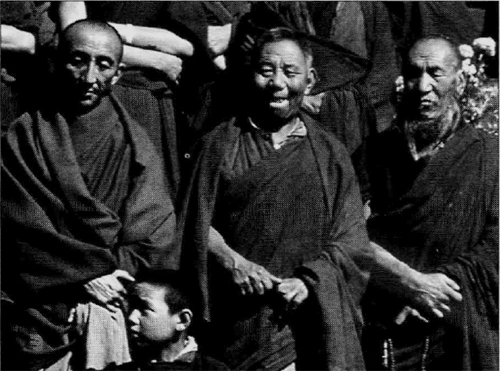
Monks and Korshak Bakula (Leh)
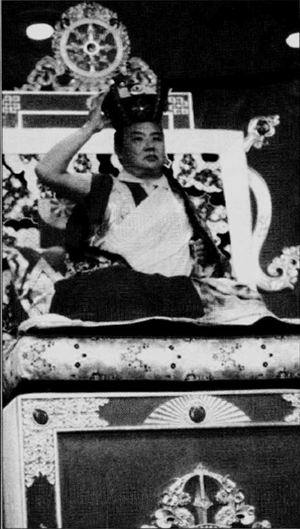
His Holiness the Sixteenth Gyalwa Karmapa performing the Ceremony of the Vajra Crown (Black Hat) (Rumtek Monastery, Sikkim, 1972)
As we drove to the entrance, the round wooden door, divided in the middle, stood open in welcome. Three burgundy-robed monks stood by to receive us. A high-cheekb-oned Tibetan introduced himself.
"My name is Tashi. We are most happy to welcome you. It is very auspicious. You have arrived just in time for the Black Hat Ceremony. This event takes place once a month at the time of the full moon." We thought it a coincidence; the monks thought otherwise."Please follow me." We crossed the enclosed courtyard. Ahead stood the main building. Through the painted doors we could see a high-ceilinged room, filled with long benches on which sat monks of all ages from ancients down to those of five- or six-years-old. A huge, golden Buddha watched over ail. The ceiling held bells of ail descriptions. Long, brocaded panels, statues, butter lamps, and old thangkas cluttered every available spot. Incense curled through the air.
We were led up a worn and uneven wooden staircase to a spacious, high-ceilinged room at the top of the monastery. Both ends of the room were opened to the temple below. We had no sooner seated ourselves on the floor than the ceremony began. We had arrived at curtain time.Darkly clad monks slowly paraded in with long copper horns, at least eight feet in length. Standing to the side of a high, throne-like chair and platform, they blew long, discordant, sonorous notes. Soon another group arrived, escorting to the seat of honor a stocky young man, who wore a high-peaked, brocaded lama's hat. Adjusting his heavy, gold-embroidered cape, he beamed happiness down upon us. He nodded his head to the monks to proceed.
"That is His Holiness, the Gyalwa Karmapa," Tashi informed me, handing out some papers of explanation. The Karmapa was the sixteenth incarnation of a Tibetan saint, recognized as the embodiment of Avalokitesvara (the Buddha of compassion) who attained enlightenment in one lifetime. His followers are called the Karma Kagyus. The Black Hat, which was made of human hairs in the eleventh century by devoted followers, was believed to have tremendous healing effects for viewers. "The Karmapa and the Dalai Lama are the two God-Kings of Tibet. Sikkim and Bhutan revere especially the Karmapa's line," explained Tashi.
An elaborate brocade box was carried in with much fanfare and presented to the God-King. After opening the box and putting the stiff, black, onion-shaped hat on his head, the Karmapa, with one hand holding the hat in place, closed his eyes in meditation. It was signaled that we follow suit. With my eyes shut I thought to myself, a God-King-how impressive for my friends. Shankar doesn't know this. How lucky we are to be here! Later, as we were each introduced to His Holiness, we presented white prayer scarves, khatas, which Shankar had advised us to take along.
One of my friends could hardly contain himself. "Wait 'til you hear what happened to Winnie." It seemed while his wife was sitting with closed eyes, she had the cherished "golden sun" wash over her entire being. She was still in shock, but radiant.
After the Karmapa left, Tashi asked us, "Would you like to meet our sister?" We, of course, said yes and followed him along an outside ledge to a corner room. It was a breathtaking view as we looked down into the valley over the winding road we had followed. All we could see were brown mountains in every directions.
"You must come back again later, when the mountains are green." Following Tashi through a narrow frame door, I stepped into a small hall; to the left a larger room opened out. As I entered, I gasped in surprise. On a low platform sat an English woman in monk's robes. She appeared to be in her sixties and her large, pale blue eyes looked enormous because of her shaved head.
"Come in, I am Sister Palmo. It is a joy to welcome you."Recovering from our start, we formed a circle around her on the floor. As we gathered confidence, we asked questions about herself and the significance of the ceremony we had just witnessed.
"What good fortune, coming here on this particular day. It was not accidental; every movement of even a grain of sand is planned." She gently explained some of the basic Buddhist beliefs and traditions to us.Time flew by, and, unfortunately, being on a tight schedule, we could not remain long enough. Rik took me aside.
"This place is sensational. We simply have to come back here and spend more time with Sister Palmo."
While the group had tea in another room and ate the picnic sandwiches we'd brought, we made our plans with the English nun.
"Yes, yes, do come back. I knew you would want to. We are meant to become friends. If you would be so kind as to bring me a few things from the Gangtok marketplace, I would be so happy. Then you can have lunch here with me."We decided that Avi, who had joined us in Gangtok, could take the group to Calcutta the next morning, and we'd follow a day later. Shankar had suggested it earlier, "Take more time here. You can use my car and driver to go to the Bagdogra airport any time." In the jeep returning to Gangtok, we chattered like mapgies, awed by our experience at the monastery.
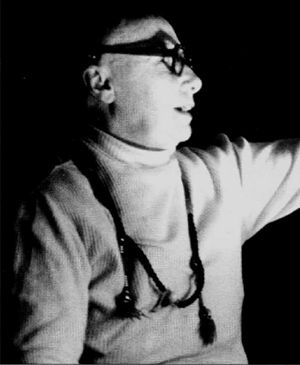
Sister Palmo at the Rumtek Monastery (1972)
That evening, we celebrated with a Tibetan dinner. The table was heaped with all sorts of succulent, hotly spiced vegetable and pork dishes. The Bajpais had outdone themselves, and they seemed proud of us as a group. We came from Argentina, Washington D.C., New York, Beverly Hills, Honolulu, and Hamburg. Included were top social names, a former U.S. Ambassador, a famous choreographer (Tony Duquette), the head of the Beverly Hills Testavant Chevalier (elite gourmet Society) and a woman astrologer, the grandniece of the legendary flying ace of World War II, Baron Manfred Von Richthofen (the Red Baron). Yes, we were an interesting assortment. We, in turn, were honored to meet the Chogyal with his American wife, Hope Cooke, and the General who had accompanied the Dalai Lama on his escape from Lhasa. The Chogyal was charming, Her Highness was shy and aloof, and the General complimented me, "That turquoise amulet you are wearing is an extremely good one."
I had bought it the day before in Gangtok. A Tibetan in dusty robes, wearing one long turquoise and coral earring had tugged at Rik's shirt. We followed him down a little alley and up a broken staircase to a tiny little room where two elderly Tibetan women sat. From under their bed, they pulled out a trunk and carefully unwrapped their treasures wrapped in dirty clothes. The minute I saw the delicate amulet, I knew I wanted it. The price was reasonable, but Rik said, in Spanish, "Mom, you've taught me to bargain. Seventy dollars is a lot in Sikkim, you will get it for less."
By bargaining, I got it for $80. We laughed at the reverse psychology of the Tibetans. The minute we started to bargain, they knew we wanted it and upped the price.
Our group left us early the next morning. Shortly afterward, I initiated Meera Bajpai into TM. Shankar scoffed, but added hastily, "I will not oppose anything that might interest her," remembering my criticism of years before. On his arrival in San Francisco as Consul General, he had been asked about Maharishi by the press. He had replied, "Oh, we laugh at all these holy men who come to the U.S. to make a fortune." I had jumped on him, "Shankar, you have never met Maharishi or taken his course. Why didn't you just say you knew nothing about him?"
By 8 A.M., the marketplace was open. Vegetables, eggs, spices, and all sorts of foodstuffs were spread out on canvasses in front of flimsy stalls. We laughed as we watched one owner beat a cow on the head as he tried to retrieve a bunch of carrots from its mouth. Succeeding, he brushed the orange roots and put them back in place-a sort of Julia Child attitude about a few teeth marks.
Soon we had our baskets filled with bread (a luxury in Rumtek), tomatoes, butter, cream, and all the requested vegetables and fruits. It was time for our return to the monastery.
"How nice to be alone!" Rik said.
Although we enjoyed our group, nearing the end of a 30-day trip, we looked forward to being on our own. Now we were off on the kind of adventure we dearly loved. It was about 11 A.M. when we drove up to the monastery door, giving us at least eight hours of daylight for a nice long visit.
Anila, Sister Palmo's tiny attendant, took our parcels from us with joy and the quick, silent movements of a bird. Sister Palmo was sitting, as she had been when we left her the day before.
"Good morning, what a treat to get all those lovely foods. Come sit near me. Are you sure you wouldn't like chairs brought in?" We assured her not.
She told us a bit about herself. She had been married to an Indian whom she had met while both were students at Oxford. They had three grown children. Their photos were beautiful.
"This one, my son Kabir Bedi, is a leading cinema star in Bombay. He's gone through a painful divorce, but is coming out of it. My husband was a businessman, but now has become a Hindu holy man and psychic healer. At present, he is touring Italy. We meet occasionally, when I go to see my children, and are good friends."
We asked how she had become a nun. "For years I followed Gandhi. One day I was attending a conference, and while walking with some friends, a voice from within spoke to me. It gave me instructions about what I was to do-I was to renounce the world of activity and become a nun in a Buddhist monastery."
Her full face glowed as she remembered. "My husband understood. He had felt the tug himself. It was a natural, happy parting, and we now travel different roads to the same destination." She must have been a young beauty, I thought. Lovely white skin, but it's hard to tell what a woman with a shaved head would look like with hair.
We discussed her early years as a nun. Evidently, as the highest in the order, she was the confidential assistant to His Holiness. She even discussed the shaving of her head.
"I guess that is the final commitment for a woman," her eyes twinkled. "You know vanity is gone when you see your hair on the floor."
We felt honored as she shared these intimacies with us. Then, abruptly, she changed the subject. "But tell me more about yourselves. What brought you here? How much do you know about Buddhism?"
I spoke first, "Well, I know that the Vedas inspired Gautama Buddha's 'seek out your own salvation,' but that he rejected the Brahmin's interpretation. Born as an Indian prince, he was horrified by what he saw outside the walls of his princely home. Needing to think, to rationalize the 'whys of creation,' he spent hours under the Bodhi tree contemplating. Occasionally he would slip into 'nothingness.' There he was free, free of worries, desires, and emotions. There he experienced total release. Austerities didn't do it, worship didn't do it; contemplation and meditation did it. It brought about the nothingness -- Nirvana!"
"Very good, that's all correct! Buddhism as explained by our Kagyu lineage also states that meditation, while unmasking our deceptions, helps us to know ourselves in the present situation, to face life, and to accept ourselves. It will bring transcendental common sense."That struck a cord with us. Rik said, "Sister, that happens to be a word we are very aware of, but please go on."
She continued, "And from Buddha's illuminations, where he transcended the limitations of individuality, he replaced the idea of the immutable, eternal soul incapable of growth and development, with the conception of a spiritual consciousness yearning for freedom and enlightenment through the continuous process of becoming and dissolving." She spoke slowly and clearly.
"Those are almost Lama Govinda's words," I exclaimed.
"Yes, he will be known to the West as the first interpreter of Tibetan Buddhism into layman's terms. He helps one understand how we must abandon our thought habits in order to know the real nature of the Mind that encompasses both the individual and the Universe."Agreeing with the Sister, I added, "The West will welcome his work. Many years ago, wanting to understand something about Buddhism, I read several books on the subject, but I gave up ... to understand them, one had to learn a whole new vocabulary."
"Indeed, and the whole idea was made easy by Buddha when he presented the eight basic rules to live by: Right Thought; Right Understanding; Right Action; Right Speech; Right Livelihood; Right Effort; Right Mindfulness; and Right Concentration."
By following these, one would become "enlightened." No longer would life be directed by attachment. The goal, actually, was to be free from the pressure of the human race.
"But, Sister Palmo, what we don't understand is this: Gautama Buddha was against gods, priests, worship, and dogma. He advised against building monasteries, as did the sages of the Upanishads, warning that, through the problems arising from household responsibilities and positions, jealousies would be born and infighting would develop between superiors and inferiors. All that was important was pure thought. Yet, when he died, they turned him into a god to worship."
"Not exactly-he's worshipped as Buddha, the Enlightened One, not as a god."Rik and I couldn't see the difference. "Isn't it a shame that man always takes simplicity and complicates it?" mused Rik.
"Man feels more secure in clinging to traditions. He needs sets of commentaries, and philosophical principles that he can classify and put down in sacred texts-man clings to 'things.' He wants to possess and make his knowledge exclusive. Even the Karmapa once admitted to me, 'It took the Red Chinese to force Tibet into sharing its wisdom with the outside world.' That was our bad karma, trying to keep it to ourselves." We admired the English nun for her honesty. What a rare treat this visit was for us. She went on to explain the symbolism found in Buddhist art and the importance it had to all meditative schools. We could have spent a week there sitting at her feet like enthusiastic little school children.
Soon it was time for lunch. Rik and I were hesitant to eat at the monastery, where sanitary conditions were uncertain, so we said we'd had a large breakfast. "Not at all, that was hours ago," insisted the nun. "Anila is cooking our meal in the next room. I have taught her to make crepes."
We couldn't believe it; I watched her cook over a little oil burner in the corner. Everything was spotless. The crepes, when served with cream and honey whipped with butter, were delicious. I'd been afraid we'd receive "buttered tea" and tsampa, made from roasted gingke, a flour-like barley mixed with yak butter.
"What a treat for me," said Sister Palmo. "Our diet is sparse here. One of the things I miss is toast with my tea. We often go weeks without bread. We raise chickens and goats outside the monastery. So it's an eggs, goat's milk, and grain menu." No wonder the foods we'd brought were thought so dazzling.
Sister Palmo was interested in hearing about Maharishi and his teachings. "He sounds like a wise man, and from the happiness you both exude, one can see it's working." We then urged her to tell us more about her life at the monastery.
She explained in detail her daily routine, how she counted hundreds of thousands of Aum mani padme hum, a Buddhist mantra, on her rosary-type beads, her mala. She told us about visualization, very important in the practice of Buddhism, and the exaltation one felt when the Buddha was seen sitting on a lotus with the honey of compassion dripping down. Even though she detailed it carefully, it was foreign to us and seemed laborious in comparison to our system.
Shortly after lunch, she announced, "Anila has brought a message that His Holiness is ready to receive you." Gathering her robes, she stood up. We had only seen her seated and were surprised to see that she was as tall as I. She walked as an English woman, with good sturdy shoes, taking long decisive steps.
From an outside door, the Karmapa's quarters were on the far side of the monastery. The room was bare, but lighted by many windows. On a small divan-like platform sat His Holiness. Without his hat and heavy cape, he looked younger than he had the day before. Now, he wore a simple wine-red robe. He smiled in welcome, indicating we should sit on cushions near him.
Then we had a surprise. A beautiful Indian woman entered the room. It was Goodie Oberoi. Sister Palmo was delighted to find we knew each other, and left us with Goodie to interpret. "How is it that you are here?" I asked. She had been one of the Indian friends I'd brought to Maharishi for initiation while I was attending the 1969 course in Kashmir. She hadn't mentioned the Karmapa to me.
"His Holiness is my treasured teacher now and has helped me more than anyone in the world." I could understand her need of help. Her life with Bikki, son of the hotel tycoon, had to be difficult. Bikki's love of drinking and women were well-known among the social set of India.
"Sister comes to visit us and now we have one of her nuns with us at home. You have no idea, Nancy, what a wonderful change it has brought over the children. I will always love Maharishi," she continued, "but, for me, I need personal contact with my spiritual guide." Her handsome face looked more serene than I had ever seen it.
Interpreting was difficult. The Karmapa spoke rapidly. His man translated the Tibetan into Hindi; then Goodie put the Hindi into English. It discouraged any substantial penetration of his knowledge. We were left with the simple enjoyment of sitting near him and receiving his serene vibrations.
"This is a most wonderful soul," Goodie explained. "You are fortunate to see him like this and share his darshan. He is revered as a God King by the Sikkimese, Bhutanese, and many Tibetans. He is the Supreme head of the Kagyu Order of Tibetan Buddhism, the embodiment of the power and compassion of Buddhist Tantra. They consider him a higher incarnation than the Dalai Lama. When the Chinese invaded Tibet, India offered the Dalai Lama asylum; likewise the Karmapa, but he came here to Sikkim at the invitation of the Chogyal."
The Karmapa radiated sunshine and he was attentive when we spoke. He appeared to be in his 30s, but I heard later he was almost 50. "He would like to give you a special mantra," Goodie explained. It was an honor we couldn't refuse. We moved close to him. He had been knotting some cords while he spoke and with his expressive hands he now tied both a yellow and red cord around each of our necks. With a small pair of scissors, he cut a lock of hair from our heads.
"It is a great blessing," Goodie explained, "that he would knot the cords and put them around your necks with his own hands. It is unusual, and I'm so happy for you. You have taken refuge in the Buddha with this ceremony."
She wrote down our mantras on a piece of paper, handing it to us with some powder and pills. "Sister Palmo will explain these to you."
The good Sister was overjoyed when she heard what had transpired and clapped her hands. "When you walked into my room today and my thangka of Vajrasattva was exposed, I knew something auspicious would happen. Usually we keep that particular thangka covered."
We told her about the mantras, and she understood our dilemma. "You are right. Stick to what you are doing. But, sometimes on a special full moon, or in a time of danger, you might use them."
She explained the healing qualities of the powder and pills to which I reacted, "Oh, good, I'll take them to my husband." She agreed they might help. (Unfortunately, Tony never saw any apparent effects.)Then she asked, "Now, may I ask you a favor?" We quickly nodded. "We have a convent in Tulokpur. You mentioned you were on your way to visit His Holiness the Dalai Lama in Dharamsala, after your friends return to the U.S., to photograph the Tibetan New Year's celebration there. Tulokpur is between Dharamsala and Dalhousie. One takes a risk sending money by mail to India, but we need to get money to the monastery to feed the nuns and their cattle. Could we entrust the money to you to deliver?"
We agreed and got all the necessary instructions. We were happy we'd ordered five thangkas to be hand painted for us. We knew our money helped to fill the envelope given us.
Again the day came to an end, far too quickly. Sister Palmo escorted us to the jeep. "We will keep in touch through letters, and one day I will come to see you in the U.S. You will come back to Rumtek. It is written." In fact, the following year she stayed with us in Beverly Hills and made a lasting impression on my family. I felt my children were fortunate to meet such dedicated people.As we rode down the hill, our minds relived our beautiful experience. "Where else could such a thing happen?" Rik said. "Here we are with the money for their convent's food, and they know nothing about us. We'll have to be so careful not to have anything happen to us, or those poor animals and people will starve!"
Later, we learned, the Karmapa, with his powers, probably knew more about us than we did ourselves! But we were complimented by their blind trust, and we did deliver the money safely.
My encounters with the world of Buddhism started with Lama Govinda, followed by the Dalai Lama, and now continued with the Karmapa. The more I was exposed to their spiritual leaders, the more attracted I became. There was no doubt that I felt a kindred spirit for the Tibetan race. They are bright, outgoing, and friendly in spite of the terrible hardships their people and homeland have suffered; they are optimistic and determined to succeed. Maybe I had been a Tibetan in one of my past lives.

